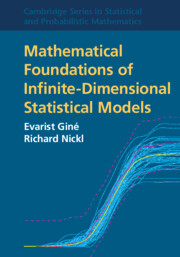Refine search
Actions for selected content:
48581 results in Computer Science
KOLMOGOROV BOUNDS FOR THE NORMAL APPROXIMATION OF THE NUMBER OF TRIANGLES IN THE ERDŐS–RÉNYI RANDOM GRAPH
-
- Journal:
- Probability in the Engineering and Informational Sciences / Volume 36 / Issue 3 / July 2022
- Published online by Cambridge University Press:
- 08 March 2021, pp. 747-773
-
- Article
- Export citation
CARNAP’S PROBLEM FOR MODAL LOGIC
- Part of
-
- Journal:
- The Review of Symbolic Logic / Volume 16 / Issue 2 / June 2023
- Published online by Cambridge University Press:
- 08 March 2021, pp. 578-602
- Print publication:
- June 2023
-
- Article
- Export citation

Mathematical Foundations of Infinite-Dimensional Statistical Models
-
- Published online:
- 05 March 2021
- Print publication:
- 25 March 2021
Preface
-
- Book:
- Approaches and Frameworks for HCI Research
- Published online:
- 24 February 2021
- Print publication:
- 04 March 2021, pp xi-xii
-
- Chapter
- Export citation
15 - Case Studies for General Framework
-
- Book:
- Approaches and Frameworks for HCI Research
- Published online:
- 24 February 2021
- Print publication:
- 04 March 2021, pp 239-253
-
- Chapter
- Export citation
5 - Art Approach and Framework for HCI Research
-
- Book:
- Approaches and Frameworks for HCI Research
- Published online:
- 24 February 2021
- Print publication:
- 04 March 2021, pp 44-63
-
- Chapter
- Export citation
Copyright page
-
- Book:
- Approaches and Frameworks for HCI Research
- Published online:
- 24 February 2021
- Print publication:
- 04 March 2021, pp iv-iv
-
- Chapter
- Export citation
9 - Engineering Approach and Framework for HCI Research
-
- Book:
- Approaches and Frameworks for HCI Research
- Published online:
- 24 February 2021
- Print publication:
- 04 March 2021, pp 123-144
-
- Chapter
- Export citation
Postscript
-
- Book:
- Approaches and Frameworks for HCI Research
- Published online:
- 24 February 2021
- Print publication:
- 04 March 2021, pp 268-270
-
- Chapter
- Export citation
4 - Innovation Approach and Framework for HCI Research
-
- Book:
- Approaches and Frameworks for HCI Research
- Published online:
- 24 February 2021
- Print publication:
- 04 March 2021, pp 23-43
-
- Chapter
- Export citation
1 - Approaches and Frameworks for HCI Research
-
- Book:
- Approaches and Frameworks for HCI Research
- Published online:
- 24 February 2021
- Print publication:
- 04 March 2021, pp 1-6
-
- Chapter
- Export citation
Dedication
-
- Book:
- Approaches and Frameworks for HCI Research
- Published online:
- 24 February 2021
- Print publication:
- 04 March 2021, pp v-vi
-
- Chapter
- Export citation
3 - Frameworks for HCI Research
-
- Book:
- Approaches and Frameworks for HCI Research
- Published online:
- 24 February 2021
- Print publication:
- 04 March 2021, pp 13-22
-
- Chapter
- Export citation
13 - Assessing General Framework against HCI Theories
-
- Book:
- Approaches and Frameworks for HCI Research
- Published online:
- 24 February 2021
- Print publication:
- 04 March 2021, pp 208-226
-
- Chapter
- Export citation
16 - Approaches and Frameworks for HCI Research: Lessons Learned and Lessons Remaining
-
- Book:
- Approaches and Frameworks for HCI Research
- Published online:
- 24 February 2021
- Print publication:
- 04 March 2021, pp 254-267
-
- Chapter
- Export citation
6 - Craft Approach and Framework for HCI Research
-
- Book:
- Approaches and Frameworks for HCI Research
- Published online:
- 24 February 2021
- Print publication:
- 04 March 2021, pp 64-82
-
- Chapter
- Export citation
10 - General Approach and General Framework for HCI Research
-
- Book:
- Approaches and Frameworks for HCI Research
- Published online:
- 24 February 2021
- Print publication:
- 04 March 2021, pp 145-157
-
- Chapter
- Export citation
Index
-
- Book:
- Approaches and Frameworks for HCI Research
- Published online:
- 24 February 2021
- Print publication:
- 04 March 2021, pp 278-282
-
- Chapter
- Export citation
14 - Methodological Component for General Framework
-
- Book:
- Approaches and Frameworks for HCI Research
- Published online:
- 24 February 2021
- Print publication:
- 04 March 2021, pp 227-238
-
- Chapter
- Export citation

